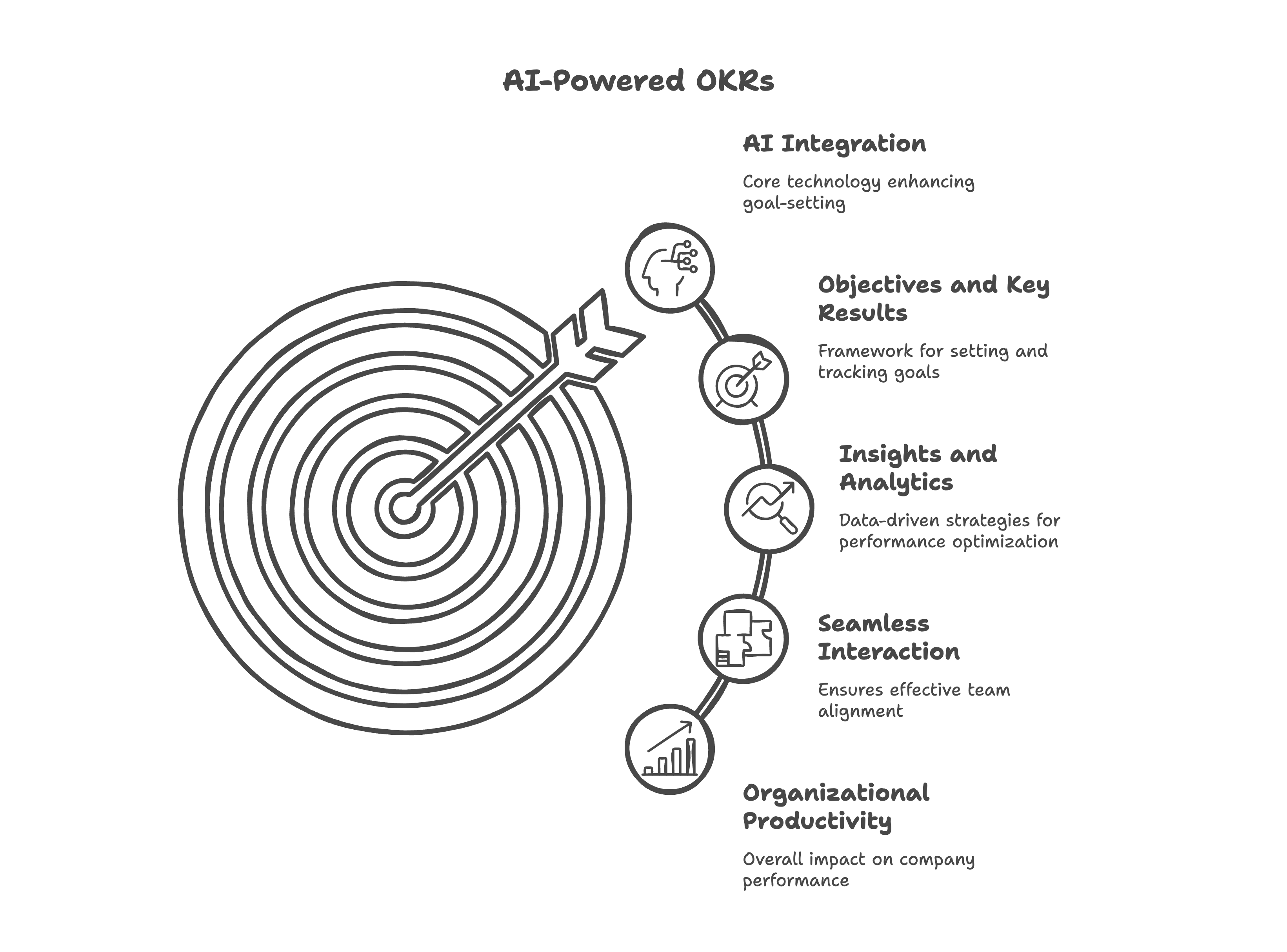AI-Powered OKRs – TL;DR
Most goal programs die in the gap between setting intentions and doing the weekly work. AI can close that gap—by watching the work, surfacing insights, and nudging the right conversations at the right cadence. Brev’s AI-powered goal management stitches your OKRs/KPIs to your WBRs, standups, and MBRs so progress updates, risks, and next moves are always current—without manual chasing.
The Problem With “Set-and-Forget” Goals
If you’ve ever run OKRs, you’ve seen the pattern:
-
Big plans in Q1; crickets by Q3
-
Spreadsheets and decks that are out of date the moment they’re shared
-
Leaders guessing who’s blocked and where execution is drifting
-
Endless status meetings where everyone rewrites the same update in a different template
The outcome: slowed execution velocity, missed alignment, and a frustrated team.
Traditional goal software digitized the spreadsheet but didn’t solve the human bandwidth problem. AI can.
What “AI-Powered OKRs” Actually Mean
“AI” can be a buzzword, so let’s be concrete. In Brev, AI does three high-leverage jobs:
-
Auto-Collect & Contextualize Signals
-
Pulls progress data from the tools you already use (tasks, PRs, CRM, product analytics, etc.).
-
Links that work to specific goals automatically (“This PR moved KPI X by 4%”, “This customer call affects Objective Y”).
-
-
Summarize, Synthesize & Spot Risk
-
Writes the update drafts for you: wins, misses, deltas, risks, and next steps—tailored to the cadence (daily standup vs. weekly business review vs. board-ready MBR).
-
Flags drift (“We’re 60% through the quarter but only 25% to target”), dependencies, and repeated blockers before they surprise you.
-
-
Drive the Rhythm, Not Just the Record
-
Orchestrates your operating cadence: reminds owners ahead of WBRs, assembles the deck, distributes highlights to stakeholders, and captures decisions.
-
Learns which metrics matter to whom and routes insights where they’ll have leverage.
-
AI isn’t “magic”—it’s leverage. It removes human copy-paste and elevates humans to make calls, unblock, and re-align.
We put together a list of the top 5 AI-powered OKR tools.
How Brev Bakes Rhythm Into Results
We built Brev on the idea that rhythm = results. Here’s how the platform makes your cadence run itself:
1. AI-powered OKRs as Living Objects
-
Set OKRs/KPIs once.
-
Connect them to data streams.
-
Let AI keep them up to date and narrate the story each week.
2. Cadence Templates (WBRs, MBRs, QBRs, Standups)
-
Pre-built review formats: Wins, Lowlights, Risks, Learnings, Executive Summary.
-
AI fills them with the freshest info; teams just confirm or add nuance.
-
No more “Can everyone update the doc by EOD Friday?”
3. Execution Velocity Tracker
-
See how often work moves goals forward (or not).
-
Spot bottlenecks by team, goal, or workflow step.
-
AI surfaces pattern-based insights (“Marketing is shipping, but not on the KPIs we care about”).
4. Decision Memory
-
The “why” behind pivots, trade-offs, and re-scopes gets captured automatically.
-
AI threads decisions back to goals so new teammates (or future you) understand context fast.
What Changes For Your Team with AI-powered OKRs
What changes:
-
Status writing, deck building, and meeting prep become near-zero effort.
-
Leaders get signal instead of noise.
-
Goals aren’t museum pieces—they’re operational dashboards.
What doesn’t:
-
Humans still choose direction, resolve conflicts, and adjust strategy.
-
Teams still meet—but to make decisions, not recite updates.
A Week in the Life AI-powered OKRs
Monday: AI posts a concise “State of the OKRs” to your WBR channel, pulling last week’s commits, deals, tickets, and experiments into the Wins/Lowlights/Risks model your org uses.
Wednesday: A product manager gets a nudge: “Feature X hasn’t moved KPI Y in 2 weeks—want to revisit the hypothesis?”
Friday: Brev drafts your MBR slide pack. Execs skim and add commentary in minutes instead of hours.
Anytime: You ask, “Where are we drifting?” and Brev shows a ranked list of OKRs with lagging progress vs. plan—plus suggested next moves.
Measurable Benefits
-
Update Time ↓ ~80%: Teams stop re-typing status and rely on AI drafts.
-
Visibility ↑ Across Functions: Everyone sees the same, fresh source of truth.
-
Execution Velocity ↑: The right issues surface faster; course-corrections happen sooner.
-
Onboarding Time ↓: New hires grok the current state (and history) of OKRs instantly.
Getting Started in 3 Steps
-
Define Your Rhythm: Pick or refine your cadence (weekly reviews, monthly exec readouts, quarterly reset).
-
Connect Your Data: Link Brev to the tools where work lives.
-
Let AI Draft—You Edit: Approve the first few cycles, teach it your tone, and watch manual work disappear.
Frequently Asked (Real) Questions
“Will AI misinterpret our OKRs?”
It learns from your corrections and context. Think of the first 1–2 cycles as training wheels; after that, drafts feel eerily on-point.
“Do we still need meetings?”
Yes—but shorter and more decisive. Brev removes the ritual of reading out loud.
“How do we keep humans accountable?”
AI doesn’t remove owners. It makes ownership visible and the work to prove progress effortless.
The Future: Autonomous Ops, Not Autonomous Teams
We’re not building robots to run your company. We’re building a system that makes your company’s operating rhythm self-healing. When the cadence runs itself, humans can focus where they’re uniquely valuable: strategy, creativity, and judgment.
Ready to Stop Herding Updates and Start Moving Faster?
See a live demo (15 minutes)
Try Brev free with your next WBR
Or just reply “OKR” and we’ll set up your first AI-powered OKR system
Let’s make your goals work as hard as your team does.
